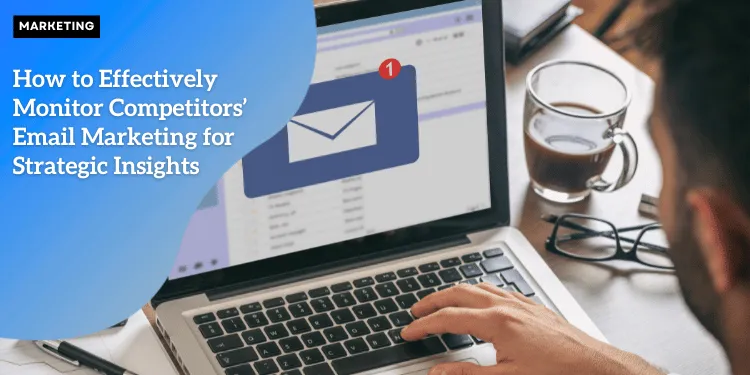How to Effectively Monitor Competitors’ Email Marketing for Strategic Insights

Anúncios
Introduction:
In the world of ecommerce, staying ahead of the competition is vital for business growth.
While many new businesses focus their attention primarily on advertising and search engine optimization (SEO) in the early stages, competitive monitoring is increasingly becoming a staple in the marketing toolkit.
Among the most powerful tools for gaining a competitive advantage is email marketing.
By monitoring the email campaigns of competitors, ecommerce marketers can uncover strategic insights, learn from their successes, and identify gaps in their own approach.
Anúncios
Thanks to advancements in technology, particularly in artificial intelligence (AI), businesses can now track their competitors’ email marketing efforts with greater ease and efficiency.
What once required sophisticated, expensive tools is now accessible to even the smallest businesses.
By leveraging platforms like Zapier, ChatGPT, and other AI-driven email-tracking tools, companies can streamline the process of competitive analysis.
Anúncios
In this article, we will explore how ecommerce marketers can use AI to monitor their competitors’ email marketing campaigns, the key aspects to track, and how to turn these insights into actionable strategies for improving your own campaigns.
 Email Marketing
Email Marketing
Why Monitoring Competitors’ Email Marketing Matters:
Competitor analysis is an essential aspect of staying competitive in the crowded ecommerce space.
By carefully examining competitors’ email marketing strategies, businesses can:
| Scenario | Before | After (Competitor Analysis) |
|---|---|---|
| 📊 Industry Trends | Limited awareness of industry trends | Gain insights from competitor campaigns to stay updated on trends |
| ✉️ Email Campaign Refinement | Trial and error with email strategies | Refine strategies based on competitor successes and failures |
| 🔍 Untapped Opportunities | Limited market exploration | Identify gaps and unaddressed customer segments from competitor emails |
| 💬 Customer Engagement | Basic email engagement tactics | Adopt competitor engagement tactics to boost conversions |
How to Track Competitors’ Email Marketing Campaigns:
While there are many tools available for monitoring competitors’ email marketing, advancements in artificial intelligence and automation have made this process easier and more affordable.
With a combination of simple tools like Zapier and AI tools like ChatGPT, you can track, analyze, and extract valuable data from competitors’ email campaigns.
Here’s a step-by-step guide on how to monitor competitors’ email campaigns:
1. Sign Up for Competitors’ Email Lists
The first step in monitoring your competitors is to subscribe to their email lists.
While this may seem obvious, many businesses fail to realize the importance of signing up for multiple email lists from the same competitor.
Here’s why:
-
📊 Audience Segmentation: Signing up multiple times with different details, such as variations of your name or using different email addresses, can allow you to observe how your competitor personalizes their campaigns. Are they segmenting their audience based on demographics, behaviors, or purchase history?
-
📧 Understanding Messaging: Each email address may result in a different message, allowing you to gather insights into the kind of offers, content, and messaging your competitor is using to reach distinct audience segments.
2. Automatically Forward Emails to Zapier
Once you have signed up for your competitors’ email lists, the next step is to use an email parser like Zapier to streamline the tracking process.
With Zapier, you can automate the forwarding of incoming email messages to a specific platform for analysis.
-
📧 Email Parsing: Zapier allows you to parse emails, extracting essential data such as subject lines, CTAs, promotional offers, and product details. This process ensures that valuable information is captured without manual effort.
-
⏳ Time-Saving Automation: By automating the forwarding process, you eliminate the need to sift through emails manually. You can focus on analyzing the data rather than spending time organizing the information.
3. Use AI Tools to Analyze the Data
Once you have parsed the competitor email data through Zapier, the next step is to use AI tools like ChatGPT to analyze and extract meaningful insights from the collected emails.
ChatGPT can be used to:
-
🔍 Identify Patterns and Trends: AI can sift through the data to identify recurring patterns in subject lines, content strategies, promotional offers, and CTAs. This enables you to spot trends and replicate successful tactics in your own campaigns.
-
📊 Extract Actionable Insights: ChatGPT can help summarize key insights from the emails, allowing you to quickly grasp important details such as customer engagement strategies, frequency of promotional emails, and content marketing approaches.
4. Store Data in a Centralized Platform
After using AI tools to extract relevant insights, it’s time to store the data in an organized and accessible format.
Google Docs, Airtable, or other project management tools can be used to store this data.
Centralized storage makes it easy to reference competitor strategies, compare different campaigns, and track your progress over time.
-
📊 Data Organization: By organizing the data in a structured format, you can quickly identify key metrics and trends that are useful for your own email marketing strategy.
-
🤝 Team Collaboration: If you work with a team, sharing the data in a central platform ensures that everyone has access to the same insights, enabling more informed decision-making.
5. Visualize Insights with Business Intelligence Tools
To make sense of the collected data, you can use business intelligence (BI) tools such as Looker, Tableau, or Google Data Studio.
These platforms allow you to visualize the email marketing trends and insights you’ve gathered, making it easier to track competitor performance and spot new opportunities.
-
📊 Interactive Dashboards: BI tools provide interactive dashboards that allow you to visualize key metrics, such as open rates, click-through rates, and conversion rates, for competitor email campaigns.
-
📈 Data-Driven Decisions: With visual insights, you can make informed, data-driven decisions about how to adjust your email marketing strategy to outperform competitors.
Key Metrics to Track When Monitoring Competitors’ Emails:
When analyzing competitors’ email campaigns, there are several key metrics and behaviors to monitor for both insights and opportunities.
These include:
1. Audience Segments and Personalization
-
🎯 Segmentation Strategies: Does your competitor send targeted messages to different audience segments, such as loyal customers or first-time buyers? Understanding their segmentation approach can help you refine your own targeting efforts.
-
💌 Personalization: How personalized are the emails? Do they use dynamic content or personalized subject lines to increase relevance? Tailoring your emails to specific customer needs can significantly improve engagement.
2. Email Timing and Frequency
-
⏰ Optimal Timing: What time of day or day of the week do your competitors send their emails? Understanding when they send messages can help you determine the best times to schedule your own campaigns for maximum impact.
-
📅 Frequency of Emails: Monitor how often your competitors send emails. Are they sending emails daily, weekly, or sporadically? The frequency of email campaigns can influence customer engagement and retention.
3. Email Sequences and Behavioral Triggers
-
📧 Behavior-Based Emails: Do your competitors employ automated email sequences based on customer behavior, such as cart abandonment or post-purchase follow-ups? Analyzing these triggers will give you ideas on how to automate and optimize your own campaigns.
-
🔢 Email Series Length: How long are their email sequences? Do they send a series of welcome emails, or is there a single promotional offer? Knowing this will help you plan the structure of your email marketing automation.
4. Subject Lines and Preview Text
-
🔄 A/B Testing of Subject Lines: Do your competitors A/B test their subject lines? What types of subject lines seem to generate the most opens? Subject lines are a key factor in open rates, and testing variations can lead to improved results.
-
👀 Preview Text Analysis: What is the preview text that appears along with the subject line? Is it engaging and persuasive, or does it lack impact?
5. Promotional Structure and Offers
-
🎁 Promotional Strategies: Do competitors offer discounts, bundle deals, or limited-time promotions in their emails? Are these offers product-specific or storewide? Understanding their promotional strategies helps you develop more compelling offers for your customers.
-
🔄 Repetition of Offers: Are there recurring offers, such as a “buy one, get one free” promotion, that appear regularly in their campaigns? This can help you decide whether to implement similar offers or explore new ways to incentivize customers.
Conclusion:
In today’s competitive ecommerce environment, monitoring competitors’ email marketing campaigns is a powerful way to gain insights, identify opportunities, and stay ahead of the curve.
By utilizing AI tools like Zapier and ChatGPT, you can automate the process of tracking competitor email campaigns, gather actionable insights, and optimize your own email marketing strategies.
Whether you’re looking to refine your subject lines, improve your email frequency, or identify untapped customer segments, competitor email analysis can give you a strategic edge.
By implementing the steps outlined in this guide and focusing on key metrics such as audience segmentation, email timing, and promotional strategies, you can drive better results from your email marketing campaigns and ultimately achieve greater success in the competitive world of ecommerce.
